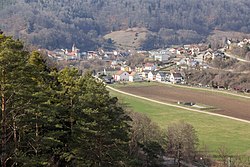Solnhofen
| Solnhofen | ||
|---|---|---|

View on Solhofen
|
||
|
||
| Coordinates: 48°53′N 11°0′E / 48.883°N 11.000°ECoordinates: 48°53′N 11°0′E / 48.883°N 11.000°E | ||
| Country | Germany | |
| State | Bavaria | |
| Admin. region | Mittelfranken | |
| District | Weißenburg-Gunzenhausen | |
| Government | ||
| • Mayor | Manfred Schneider | |
| Area | ||
| • Total | 13.50 km2 (5.21 sq mi) | |
| Elevation | 410 m (1,350 ft) | |
| Population (2015-12-31) | ||
| • Total | 1,717 | |
| • Density | 130/km2 (330/sq mi) | |
| Time zone | CET/CEST (UTC+1/+2) | |
| Postal codes | 91807 | |
| Dialling codes | 09145 | |
| Vehicle registration | WUG | |
| Website | www.solnhofen.de | |
Solnhofen is a municipality in the district of Weißenburg-Gunzenhausen in the region of Middle Franconia in the Land of Bavaria in Germany. It lies within the Altmühl Valley.
The local area is famous in geology and archaeology for Solnhofen limestone. This is a very fine-grained limestone from the Jurassic period which is an exceptionally fine Lagerstätte that preserves detailed fossil specimens. Alois Senefelder used specially prepared blocks of the fine Solnhofen limestone for the process of lithography which he invented in 1798. The quarrying of this lithographic limestone subsequently yielded spectacular finds, including Archaeopteryx, commemorated in the bird's full name Archaeopteryx lithographica. All 13 known specimens have come from the Solnhofen area.
Solnhofen is located on the Altmühl in Bavaria. It contains two districts: Hochholz and Eßlingen. It is adjacent to the cities Pappenheim, Langenaltheim and Mörnsheim.
Solnhofen was known as "Husen" in the 8th century. In 750/51 Saint Solus created a church there. On this church, the grave church of him (Sola-Basilika) was built later. In honor of him Husen was renamed in "Solnhofen". In 1420 Solnhofen was burnt down during the Bavarian War. It also suffered through the Thirty Years' War. From 1649 to the 18th century there was a glass industry in Solnhofen. In 1785 the St. Veit-church was erected partly on the ruins of the old grave church. In 1870 the train station was opened. From 1903 to 1905 the Catholic St. Sola-church was built. In 1970 the Bürgermeister-Müller-Museum was opened.
...
Wikipedia



